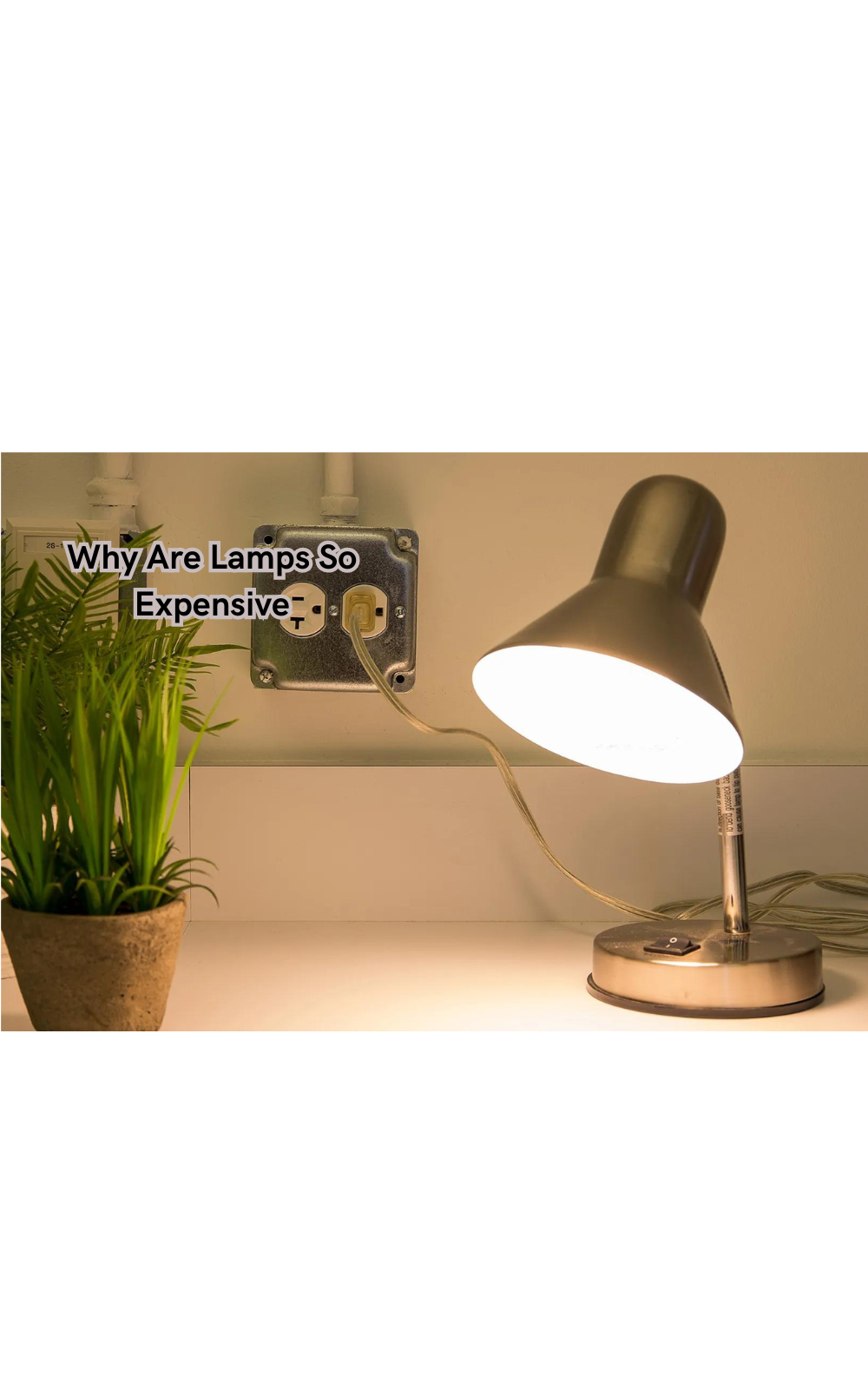Why Are Lamps So Expensive
From hand-blown glass to intricate metalwork, each lamp tells a story of skilled artisans' meticulous attention to detail.

Lamps, often overlooked yet essential interior decor elements, possess a charisma that transcends mere functionality. The allure of lamps lies in their ability to transform a space, casting warm glows that evoke ambiance and sophistication. The craftsmanship and design intricacies that define premium lamps contribute to their elevated price points, reflecting a fusion of artistry and utility.
From hand-blown glass to intricate metalwork, each lamp tells a story of skilled artisans' meticulous attention to detail. The exclusivity and uniqueness of high-end lamps appeal to discerning individuals seeking illumination and a statement piece that elevates their living spaces. But what exactly makes lamps so expensive?
The Basics of Lamp Technology and Types
Before delving into the reasons behind lamps' high price tags, it's essential to understand the basics of lamp technology and types. The most common lamps are incandescent, fluorescent, LED, and halogen.
Incandescent bulbs use a filament heated by an electric current to produce light, while fluorescent bulbs use gas and mercury vapor to create energy that produces light. Floor lamps, table lamps, desk lamps, and wall sconces are some widely used lamps.
LED (Light Emitting Diode) lamps are the most energy-efficient, using semiconductors to convert electricity into light. Halogen lamps use a tungsten filament inside a halogen gas-filled bulb, creating a brighter and more focused light than incandescent bulbs.
Each type of lamp varies in cost and efficiency, with high-end LED and halogen lamps often costing more due to their advanced technology and energy-saving properties.
Factors That Contribute to the High Cost of Lamps
Now that we understand the basics of lamp technology let's explore some factors that contribute to the high cost of lamps.
Quality of Materials
One of the primary reasons behind the high cost of lamps is the use of premium materials in their construction. From hand-blown glass to high-quality metals and natural materials like marble and wood, these materials add a luxurious touch to lamps and drive their price.
Skilled artisans carefully select and craft each material, ensuring that every lamp is unique. A solid brass or copper base, for example, not only adds to a lamp's aesthetic appeal but also ensures its durability and longevity.
Design and Craftsmanship
Design intricacies and craftsmanship also significantly influence lamps' price points. High-end lamps often feature intricate patterns, textures, and finishes that require skilled artisans to create by hand.
Whether it's intricate metalwork or delicate glass-blowing techniques, these elements add artistry and craftsmanship to lamps that justify their high prices.
Exclusivity and Uniqueness
Another factor contributing to lamps' high cost is their exclusivity and uniqueness. Many high-end lamp manufacturers produce limited quantities of each design, making them highly sought after by interior designers and collectors.
This scarcity factor drives up the price for these lamps, as individuals are willing to pay a premium for a one-of-a-kind piece that adds character and sophistication to their space.
A table lamp handcrafted by a renowned artisan and only available in limited quantities will undoubtedly command a higher price than a mass-produced lamp. Floor lamp designs exclusive to certain brands or regions can also drive up their cost due to their uniqueness.
Functionality and Features
While lamps may look like simple objects, they offer a range of functionalities and features that justify their high price points. From adjustable brightness LED lights to adjustable arms for precise lighting, these added functions enhance the user's experience and make the lamp more versatile.
These advanced features require additional technology and engineering, which drive up the cost of production.
Brand Reputation and Marketing
As with any luxury item, brand reputation and marketing also factor into the high cost of lamps. Established brands with a strong reputation for quality and design can command higher product prices.
Additionally, extensive marketing efforts to create a sense of exclusivity and desirability can contribute to the price of lamps.
Lighting solutions from renowned designers or collaborations with famous artists can also drive up costs due to their brand name and prestige. Lighting industry trends and consumer demand also play a role in determining the price of lamps, with popular styles and designs often costing more due to their high demand.
Advanced Technology and Energy Efficiency
Lastly, using advanced technology and energy-efficient features also contributes to the high cost of lamps. LED and halogen lamps, for example, maybe more expensive initially, but their long lifespan and energy-saving capabilities make them a more cost-effective choice.
These lamps often come with a higher initial investment. Still, their durability and energy efficiency make them a popular choice for those looking to save on their energy bills in the long term.
So, many factors contribute to the high cost of lamps, from LED technology to handcrafted designs and exclusive materials. While they may be pricier than their more basic counterparts, high-end lamps add a touch of luxury, elegance, and functionality to any space, making them a worthwhile investment for those seeking style and substance in their lighting solutions.
How to Choose the Right Lamp for Your Needs and Budget
With an understanding of the factors contributing to lamp prices, it's essential to know how to choose the right lamp for your needs and budget. Here are some tips:
- Consider Your Lighting Needs: Before purchasing a lamp, consider the purpose of the light. Do you need focused lighting for reading or task work? Or do you want ambient lighting to create a cozy atmosphere? Different types of lamps provide different levels and lighting, so consider your needs before purchasing.
- Evaluate the Design: Lamps come in various designs, from modern and minimalist to ornate and traditional. Consider the overall aesthetic of your space and choose a lamp that complements it. You can also use lamps as statement pieces to add character to a room, so don't be afraid to choose a unique and eye-catching design.
- Set a Budget: As discussed earlier, lamps can vary greatly in price depending on factors like materials, craftsmanship, and technology. Set a budget before shopping to ensure you stay within your means and avoid overspending.
- Quality Check: When purchasing a lamp, always check the quality of materials and construction. Ensure the lamp is sturdy and well-made, with no defects or damage. This will ensure the lamp's longevity and make it a worthwhile investment.
- Consider Energy Efficiency: As mentioned, lamps with energy-efficient features may have a higher initial cost but can save you money in the long run. If you're conscious about your electricity bill, consider investing in an energy-efficient lamp.
With these tips in mind, you can choose the right lamp for your needs and budget without compromising quality or design. Whether you're looking for a functional task light or a stylish statement piece, a wide range of lamps are available to suit everyone.
Are Light Fixtures So Expensive?
Light fixtures for lamp lighting can also be expensive for several reasons. Like lamps, these fixtures often use high-quality materials and are handcrafted or designed by renowned artists. They also offer advanced technology and energy efficiency features, making them a popular choice for those looking for stylish and functional lighting solutions.
In addition to these factors, light fixtures also require complex installation processes that may involve the expertise of electricians, further driving up the overall cost. However, just like lamps, investing in a high-quality light fixture can add value and elegance to your space.
The Future of Lamp Technology and Affordability
As technology advances and becomes more accessible, it is likely that the cost of lamps will decrease over time. LED technology, for instance, was once a luxury feature but has now become a standard in many lamps due to its energy efficiency and affordability.
Additionally, as consumers and companies alike prioritize sustainability and eco-friendliness, we may see an increase in more affordable and environmentally friendly lamp options. These could include using recycled materials or incorporating renewable energy sources into the design of lamps.
FAQs
How do lamps differentiate themselves from other lamp options in the field of interior design?
Lamps stand out through their unique designs, craftsmanship, and materials, setting them apart as premium pieces in interior decor. Plus, the functionality and versatility of lamps make them an essential element in any well-designed space.
Is it cheaper to have lamps or lights?
To save money on electricity bills, using lamps with energy-efficient features may be more cost-effective in the long run. However, traditional overhead lights are typically cheaper to install and maintain. Lamps also offer more versatility in terms of placement and lighting options than traditional lights.
What factors contribute to the high price tag attached to lamps compared to other lighting choices?
The intricate detailing, quality materials, artisanal workmanship, and exclusive designs of lamps justify their higher prices within the interior design market. Other lamp options may not offer the same level of luxury and sophistication.
Are expensive lights worth it?
For home decor enthusiasts, expensive lights can be a worthwhile investment, adding elegance and functionality to their interiors. However, it is essential to weigh the cost against your budget and needs before making a purchase.
Conclusion
In conclusion, the allure and expense of lamps in interior design stem from the fusion of exquisite craftsmanship, unique designs, and premium materials that elevate them beyond mere lighting fixtures.
The high price tags associated with lamps reflect the artistry and attention to detail invested in creating these statement pieces.
While the initial cost may seem steep, investing in quality lamps not only adds a touch of elegance to spaces but also ensures longevity, making them a worthwhile and sustainable choice for enhancing ambiance and style in any setting.
